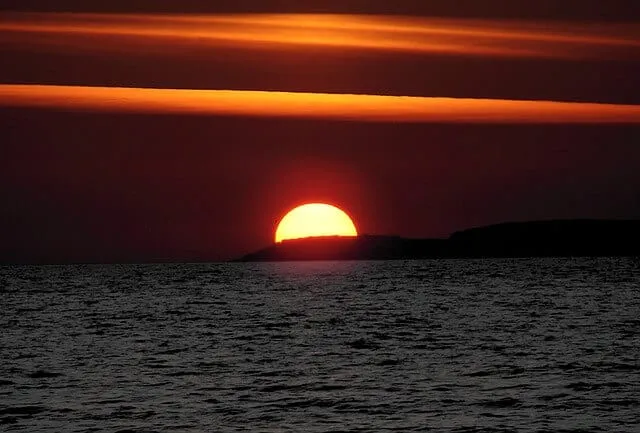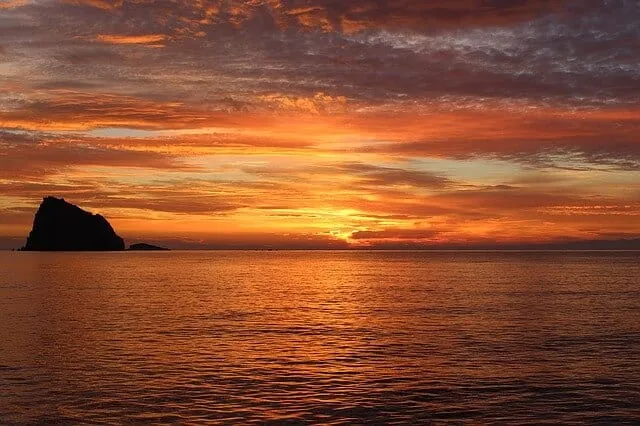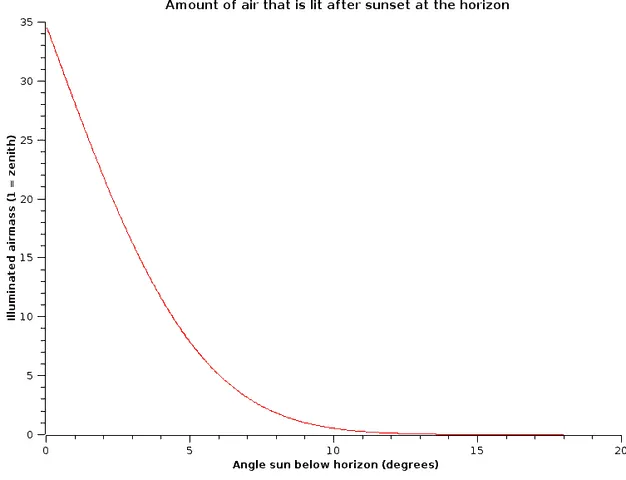When It Get Dark Outside

When will it be dark?
"How long does it accept to get dark after sunset?" is a really smart question to ask as an astronomer!
Why?
Well, y'all need to know when it's going to be properly dark and then you lot tin figure out when it'due south worth getting outside and taking a look at the night sky. Go too early and you won't come across all that y'all hoped for… but when is too early on?
If yous're in the United states and desire a quick answer, here information technology is…
Information technology will exist nighttime enough to see deep space objects
- For southern states: around lxx minutes later on dusk
- For northern states: around 100 minutes (1 hour xl minutes) after dusk
There's variation in that for your particular latitude, the season and how night yous want it to be, though.
Then, if you want to discover more than well-nigh how long it takes to get dark afterwards the lord's day sets, and then read on…
What is Astronomical Twilight?
Y'all may have heard of astronomical twilight (yes, information technology is a real thing) simply it is just the last and darkest of three recognised twilight phases.
Each twilight phase is adamant past how far the sun is beneath the horizon:
- Civil Twilight – begins at dusk (the centre of the sun is at 0° pinnacle) until it is six° below the horizon
- Nautical Twilight – starts when civil twilight ends and lasts until the centre of the sun is 12° beneath the horizon
- Astronomical Twilight – the terminal and darkest of the twilights. It begins when the sun is 12° below the horizon and ends when it reaches 18° below
Once the sun moves more than eighteen° beneath the horizon, it is officially 'night' and there is no sunlight lighting your location, perfect for taking photos of the dark sky.
What Can I See During Twilight?
Each of the iii twilights has different levels of seeing, both downward here on World and up in the dark sky. Since we don't know how far below the horizon the sun is, this elementary guide will help y'all judge based on local conditions:
Civil Twilight
- On the ground, you can still see everything clearly without extra illumination, you lot can still read a volume, for instance. Towards the end of this menstruum, machine headlamps need to be switched on and streetlamps will be lit.
- In the sky, only the brightest objects will be visible, such as Venus and Mercury
Nautical Twilight
- On the ground, calorie-free has faded at present and objects become hard to distinguish from the background or each other. They seem more than like silhouettes. You'll need additional lighting to carry on outdoor activities.Your color-seeing gives way to shades of gray as there is no longer enough light for your optics to see in color.
- In the sky, the stars come up out at present and constellations can be clearly seen. The sky itself will turn nighttime blue, and be blackness at the horizon opposite where the sun set.
Astronomical Twilight
- On the ground, it is what we would all call dark. It is truly dark. Y'all will perchance see the sky equally dark blue or off-black at the horizon nearest the sun, otherwise the sky will be black.
- In the sky, you will at present exist able to see deep space objects (with i of these telescopes), although seeing is compromised a little nearest the horizon where the sun set earlier.
Night
For most of u.s., there is little to tell different between astronomical twilight and night, except for slight differences in sky brightness at the horizon of the setting sun.
At this bespeak, the sun places no limit on the objects y'all can run into (except by reflecting off the Moon of class).
The contrary of these phases is true as nosotros head towards sunrise. Night gives manner to astronomical twilight, so nautical twilight and finally civilian twilight, which ends with the sun rise.
Why is it Not Dark as Soon as the Lord's day Sets?
It's a reasonable question to enquire.
If the source of our daylight has gone below the horizon, why does it take so long to actually become nighttime?

Why is it non dark every bit presently as the sun sets?
If we lived on a apartment disc (similar our ancestors believed) and the sun brushed the edge of it as it gear up, information technology would indeed become night-night instantly the sun was out of sight.
But, we don't.
The Earth is a sphere, has a deep atmosphere and our sunday is effectually 93 one thousand thousand miles away. When it sets beneath the horizon, the sunday continues to shine on the atmosphere to a higher place the Earth's surface.
If y'all've e'er taken a flight at the start or end of a mean solar day, you've probably experienced this for yourself.
Imagine you're on a plane high above your friend on the ground beneath. As the dominicus sets below the horizon for them, you will withal see information technology above the horizon. It is notwithstanding shining on the temper you are flight in but is not lighting the footing beneath you.
The sunlight hits the temper full of gas molecules like oxygen and nitrogen. Those gases crusade calorie-free to bounce around, or 'scatter'. Some of the scattered low-cal hits our eyes so we run across the world lit, for a short fourth dimension, subsequently the sun has set.
The sun continuing to shine on the atmosphere after it sets below the horizon is why we take three unlike twilights:

How much atmosphere is lit by the sun after dusk (source)
- At the moment of dusk, all of the atmosphere above our heads is notwithstanding lit past the sun, just the amount shrinks quickly throughout civil twilight
- At the terminate of civil twilight (i.e. sun is six° below the horizon), none of the atmosphere above our heads (the zenith) is now lit by the sun. Even so, still a third of the temper above the horizon is lit by the sun, which we run into equally lighter blue skies
- Past the start of astronomical twilight (12° below the horizon), only the very highest layers of the atmosphere at the horizon where the sun set are yet lit
- When astronomical twilight gives fashion to dark at 18° beneath the horizon, none of the atmosphere we tin see is lit by the sun
At present you lot empathise the concept of twilight, how we see them and what causes them, let'due south return to our original question…
How Long Does it Take to Get Dark After Sunset?
There are two factors that determine the answer to that question:
- Your latitude – the closer yous are to the equator, the quicker it gets dark after dusk
- The Season – In summer it takes longer to get night than winter (and may not become truly dark at all)
The Touch on of Breadth on Time to Darkness After Sunset
The sun appears to ascent and ready in a straight line at the equator. Information technology rises in the east, goes straight overhead (i.eastward. the zenith) at midday and sets directly down in the westward.
The sun appears to set at right angles to the horizon. It sinks past 6°, 12° and 18° below the horizon much faster than information technology does nearer to the poles.
Closer to the poles, the dominicus takes a more leisurely angle through the sky. It rises near the east, does not get straight up, does not get as loftier every bit the zenith at midday and sets near the westward.
This flatter angle means it takes longer for the sun to accomplish half-dozen°, 12° and xviii° beneath the horizon… so information technology takes longer to go dark.
This can exist difficult to visualise (there's a not bad explanation hither) so information technology'south simpler to testify you with a specific example.
How Long it Takes to Get Dark After the Lord's day Sets
Let'south have the March equinox (effectually March 20th) where the length of twenty-four hours is pretty much the same for everyone.
In the table below, we've compared the time from sunset to dark for the towns of Quito in Ecuador (which is about the equator), Fundamental Due west (south Us), Kansas Urban center (central US) and Anchorage (northward US).
| City | Civil Twilight (Dusk) | Nautical Twilight | Astronomical Twilight | True Nighttime |
| Quito, Ecuador | xviii:25 | 18:45 (+20mins) | xix:09 (+44mins) | 19:33 (+68mins) |
| Key W, Florida | xix:39 | xx:02 (+23mins) | 20:28 (+51mins) | 20:55 (+76mins) |
| Kansas City, Kansas | 19:32 | xix:58 (+26mins) | 20:30 (+58mins) | 21:02 (+90mins) |
| Anchorage, Alaska | twenty:18 | 21:02 (+44mins) | 21:54 (+96mins) | 22:53 (+155mins) |
Y'all can see clearly that it takes a lot less time to get dark at the equator than it does even in Primal Westward. Every bit nosotros motion northwards, away from the equator, that fourth dimension gets longer still.
At the equator, in Quito, nautical twilight starts only 20 minutes later on sunset, compared with 23 minutes in Fundamental West, 26 minutes in Kansas City, and 44 minutes in Anchorage.
And, remember, these times are all the same 24-hour interval.
If nosotros say that 'night' is our measure out of when it is truly dark, then the differences are even greater.
In Quito, it only takes just over an hour (68 minutes) to get dark afterwards sunset at the jump equinox. Move n from there and it takes 76 minutes in Key Westward, 90 minutes in Kansas Metropolis and almost 2 and a one-half hours upwards in Anchorage.
The Impact of Season on Time to Darkness After Sunset
On any given twenty-four hours, equally you've only seen, it volition take longer to get nighttime the further away you are from the equator.
Whatsoever your location, though, it takes slightly longer to get dark the closer to summertime we are. The departure is small, existence only a few minutes for mainland Us.
The biggest impact for summer darkness is that, if you alive far plenty due north, there are periods when in that location is no true 'night' at all.
Have Alaska, for instance. For most of June, the sun is never more than 6° below the horizon. Which means it never gets past ceremonious twilight, so you lot can read outside all night without an extra source of light!
You probably know that the north pole has 24hr daylight in summertime, but come down to the face-to-face states and the summer affect is not as marked.
Unless you live in the farthermost n of the country (within about 15 miles of the Canadian border), y'all'll experience true, nighttime 'night' every single day of the yr.
For example, fifty-fifty the continental United states of america'south northernmost big city, Seattle, has 2 hours of dark on the longest day of the twelvemonth.
However, just a few miles due north, at Bellingham in the north-west corner of Washington state, it'due south a different story. They have around ii weeks in mid-June where astronomical twilight doesn't end before the sun begins to rising again, at that place is no 'night'.
Epitomize of How Long Darkness Takes Afterwards Sunset
So, in that location you have it, a complete reply.
In summary, for the 48 face-to-face states, it takes anywhere from 70 to 100 minutes for information technology to get dark subsequently sunset.
The further northward y'all are, the longer it takes for true darkness to go far after sundown.
If you live at the northern border with Canada, you will experience nights in mid-June where it never gets truly dark at all. Everywhere else* does feel at least some truly night nighttime every day of the year.
If you desire to discover the twilight times for your location on whatsoever given twenty-four hours, and so check out Time and Appointment's sunrise and dusk reckoner.
*Exterior of Alaska, where it tin take twice every bit long and never gets truly dark in June
When It Get Dark Outside,
Source: https://lovethenightsky.com/how-long-after-sunset-is-it-dark/
Posted by: blairgual1950.blogspot.com


0 Response to "When It Get Dark Outside"
Post a Comment